
June 2023
Page 31
Picnic Point through the eyes of an Odyssey Project student. Page 4
the 2023 Alumni Award winners. Page 32 Herd Happiness
cattle stress lower improves herd wellness.
COMMONS
alumni and friends of the Nelson Institute for Environmental Studies at the University of Wisconsin–Madison
Dylan Bizhikiins Jennings joins the Wisconsin Natural Resources Board.
Visit
Meet
Keeping
THE
For
EDITORIAL STAFF
Kevin Berger, Graphic Designer
Eric Klister, Web Editor
Chelsea Rademacher, Editor
Diane Stojanovich, Managing Editor
STAFF WRITERS
Rachel Carrier
Anica Graney
CONTRIBUTORS
Abigail Becker
Jocelyn Cao
Dea Larsen Converse
Michael Kamp
Caroline Schneider
DEAN’S OFFICE
Paul Robbins, Dean, Nelson Institute for Environmental Studies
Anna Gade, Associate Dean for Research and Education
Colleen Godfriaux, Associate Dean for Administration
Diane Stojanovich, Distinguished Associate Dean for Communications
Shelly Strom, Assistant to Paul Robbins
Ann Swenson, Associate Dean for Advancement
CONTACT US
We’d love to hear from you! Send us feedback or questions about this issue, or share story ideas for future issues.
Nelson Institute for Environmental Studies
550 Science Hall Madison, WI 53706 communications@nelson.wisc.edu
Facebook Instagram
Twitter Linkedin
Stay connected by updating your contact information or by joining our LinkedIn group
We’re reducing our carbon footprint! We hope you enjoy our digitally published magazine, sent monthly to Nelson alumni, students, and friends.
INSIDE
FEATURES
2 Ho-Chunk Clan Circle Campus’s newest building — the Baake Recreation and Wellbeing Center — features a unique sculpture honoring the ancestral land it occupies.
4 A Sense of Place Odyssey Project students took to Picnic Point for an exercise in place-based writing.
8 Hands-On Watershed Management
Nelson graduate students shared research on watershed management with Wisconsin’s Koshkonong Creek.
12 Climate Effects on Tourism
How is tourism, one of the largest economic drivers in Wisconsin, holding up to climate change?
FACULTY/STAFF IMPACT
14 Tyler Lark, Center for Sustainability and the Global Environment
16 Bret Shaw, Department of Life Sciences Communication
18 Audrey Stanton, Office of Sustainability
FRONT AND CENTER
19 Director’s Cut, Sean Schoville
20 Can Goats Take a Bite out of Invasive Plants?
STUDENT SNAPSHOT
22 Nova Tebbe, Energy Policy and Analysis
26 Naomi Louchouarn, Environment and Resources
28 Ben Lebowitz, Environment and Resources; and Cyrus Gordon-Hill, Environmental Studies
ALUMNI SPOTLIGHT
31 Dylan Bizhikiins Jennings
32 2023 Alumni Award Winners
Cover photo by Naomi Louchouarn
From the Dean
Greetings, Nelson alumni and friends,

I hope your summer is off to a good start. Campus has been enjoying the post-semester slow-down, and I’m looking forward to spending some time helping to cement some important relationships for Nelson. I’m hoping to use the time to restart our efforts to create shared courses with the College of Menominee Nation in conservation biology and genetics. Also, Nathan Schulfer and I will be visiting Botswana this summer, to meet there with the Ministry of Environment, Natural Resource Conservation and Tourism and discuss mutual research exchanges, cross-trainings, and links to our Institute’s professional and international programs.
Both of those efforts, as grounded opportunities for environmental exchange and scholarship, represent Nelson’s commitment to taking seriously the land and people of diverse places. So, as you dive into this month’s issue of The Commons, I encourage you to do so through that lens: place. Many of these stories are rooted in the land they stand on — from public art to research to reflection. The Center for Culture, History, and Environment recently hosted its place-based workshop, during which students were prompted with questions like: What does the appearance tell you about origin or destination, how to the materials connect or interrupt each other, and how do your mind and body react to this place? I found myself thinking back to some of these questions while reading this month’s collection of stories and looking at the accompanying photos. (Stay tuned for the July edition to read some student reflections from the workshop).
It’s exciting to see a collection of stories that spans (almost) the full gamut of the Nelson Institute’s programs and partnerships. We start with our relationship to the UW’s Tribal Relations office with a photo story on the new Ho-Chunk Clan Circle along the Lakeshore Path. Further down the path at Picnic Point, you’ll see a small but mighty connection to the Odyssey Project’s writing course. Then heading east of campus, see how students in the water resources management program
found their place at Koshkonong Creek through the UniverCity Year program. Rounding out the feature section, the Wisconsin Initiative on Climate Change Impacts asks us to reflect on the entire state as a place to be explored.
We also share groundbreaking research from our Center for Sustainability and the Global Environment, the Center for Ecology and the Environment, the energy policy and analysis program, our environment and resources track, and our environmental studies major. You’ll also learn about efforts from the Nelson Institute’s affiliates and partners in the College of Agricultural and Life Sciences and the Office of Sustainability.
Finally, I’d like to call your attention to an exciting event we’re hosting this September. Our annual Rendezvous at the Terrace alumni gathering has expanded this year to celebrate a Nelson milestone: the 10th anniversary of our environmental professional programs. You’ll also have a chance to meet this year’s 2023 alumni award winners, who you can read more about on page 32. I encourage you to browse the collection of events (and start making your travel plans!)
Paul Robbins Dean, Nelson Institute

June 2023 1
Ho-ChunkClanCircle
Campus’s newest building — the Bakke Recreation and Wellbeing Center — opened on April 24 to rave reviews. Located in the footprint of the old Natatorium along the Lakeshore Path, one of the wellness destination’s most striking features is the outdoor Ho-Chunk Clan Circle. The sculpture, designed by Ho-Chunk artist Ken Lewis, honors the nation’s 12 clans. Learn more about UW–Madison’s Tribal Relations office and its beginnings in the Nelson Institute.

Feature
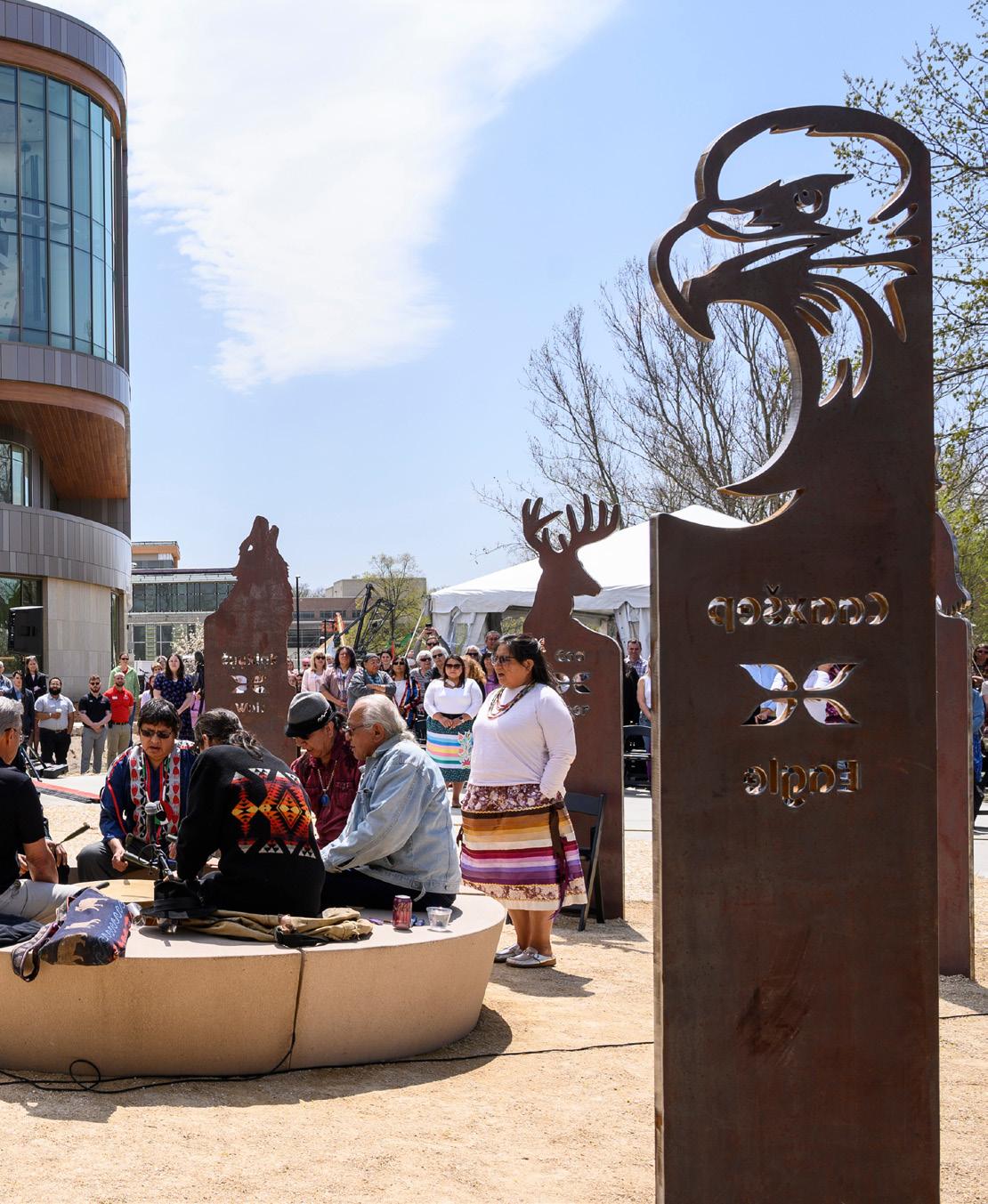
August 2021
Photo by Bryce Richter / UW–Madison
A Sense of Place
Odyssey Project students took to Picnic Point for an exercise in place-based writing with support from the Center for Culture, History, and Environment faculty associates.
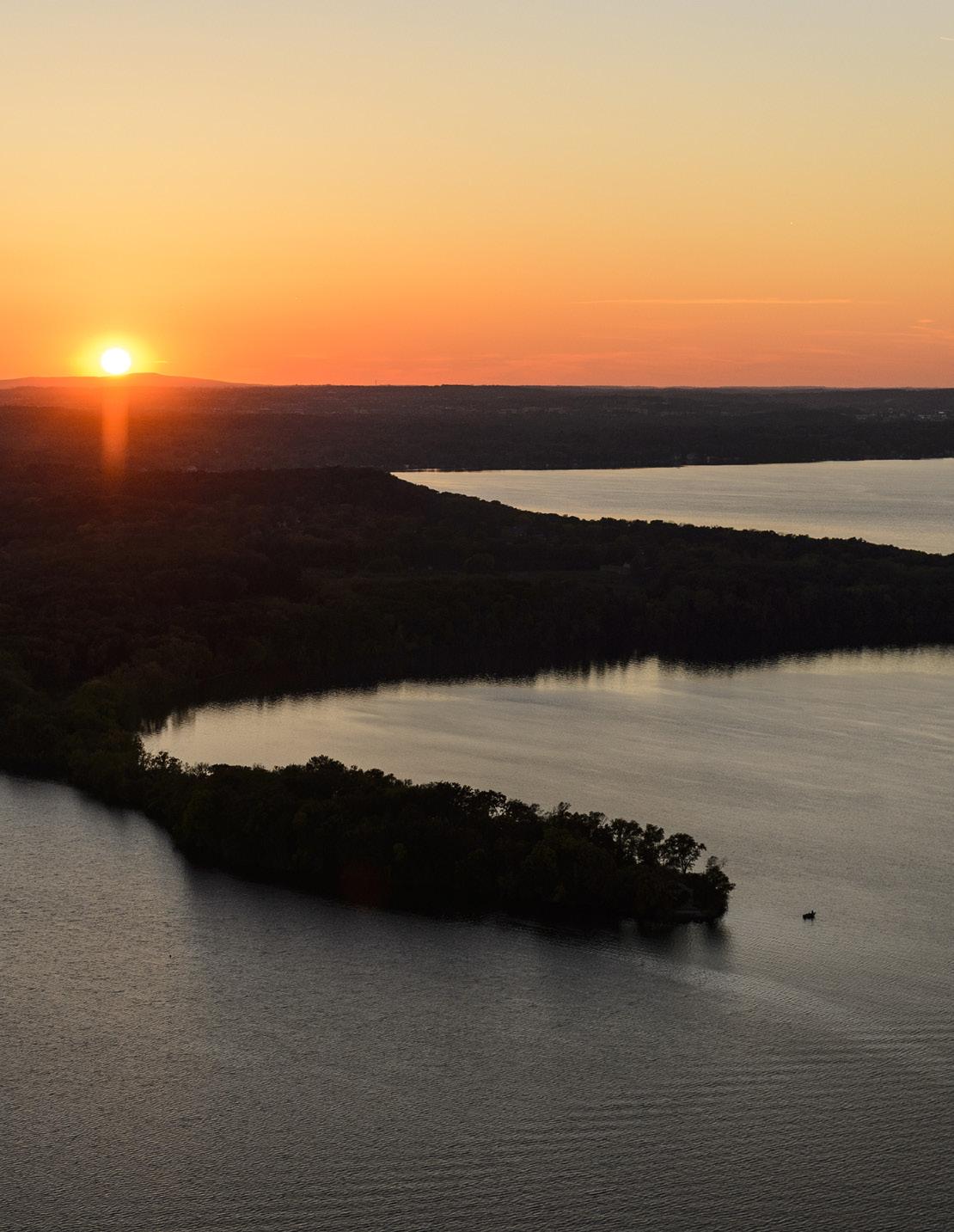
Feature
The Odyssey Project is a unique program at UW–Madison that invites adult students with economic barriers to higher education to take humanities courses on campus. Founded in 2003, the Odyssey Project has expanded to include six programs, including Odyssey Junior for kids whose parents are enrolled, and Odyssey Behind Bars, a first-step course for incarcerated individuals who want to pursue higher education.
During the Spring 2023 semester, Marina Cavichiolo Grochocki and James Spartz — Nelson faculty affiliates and associates of the Center for Culture, History, and Environment — led three sessions in the Odyssey Project’s 16-week creative writing course. Grochocki and Spartz reflected on their experience:

At the invitation of Erin Celello, instructor of the Odyssey Project’s creative writing course, we led three class sessions centered on the topic of “place.” The first one introduced the students to place concepts and was more theoretically focused: what makes a “place?” How can we use writing to better understand perspectives between the “view from somewhere” and “view from nowhere?” At the end of this first session, students were prompted to think about a specific place significant to them. This prompt involved a practical activity using both drawing and writing.
The second session took place at Picnic Point. After a brief set of prompts to “dial in” to the experiential nature of our outing, the class walked together from the main entry of UW–Madison Lakeshore Nature Preserve to the tip of Picnic Point. Around the fire circle area, students took time to free-write. Students shared sensorial impressions and memories throughout the walk, free-writing, and group sharing. We were lucky in that our outing was on one of the first warm and sunny days of the semester.
The third session was a writing workshop, where students shared drafts of their place-based writing with peers (and us!) to gather impressions and constructive feedback. Stories about friendships or fleeting romances became entangled with social issues and questions about belonging, demonstrating the pluralistic nature of “place” concepts and experiences.
Marina’s main takeaway is to always remember the importance of having concrete examples. No matter the audience, an example can more easily communicate the ideas we abstractly contemplate in academia.
One takeaway from James is how place, when approached with intention, can help facilitate connections between humans and our non-human surroundings in ways that deepen those relationships and strengthen one’s sense of self-in-place. Engaging in such experiences is vital, and writing, reflecting, and discussing with peers helps expand people’s appreciation and awareness of how important those relationships are.
Three of the students published their essays in a class booklet — The Odyssey Oracle — at the end of the semester, and several others shared theirs orally at an open mic event. Burnett Reed was one of the performers, sharing the following story about how he experienced the class trip to Picnic Point.


Feature
June 2023 5
Left: Burnett Reed workshops an essay during class in the spring semester. Right: Odyssey Project students go over course materials at the start of the semester. Photos courtesy of Erin Celello
Photo courtesy of Burnett Reed
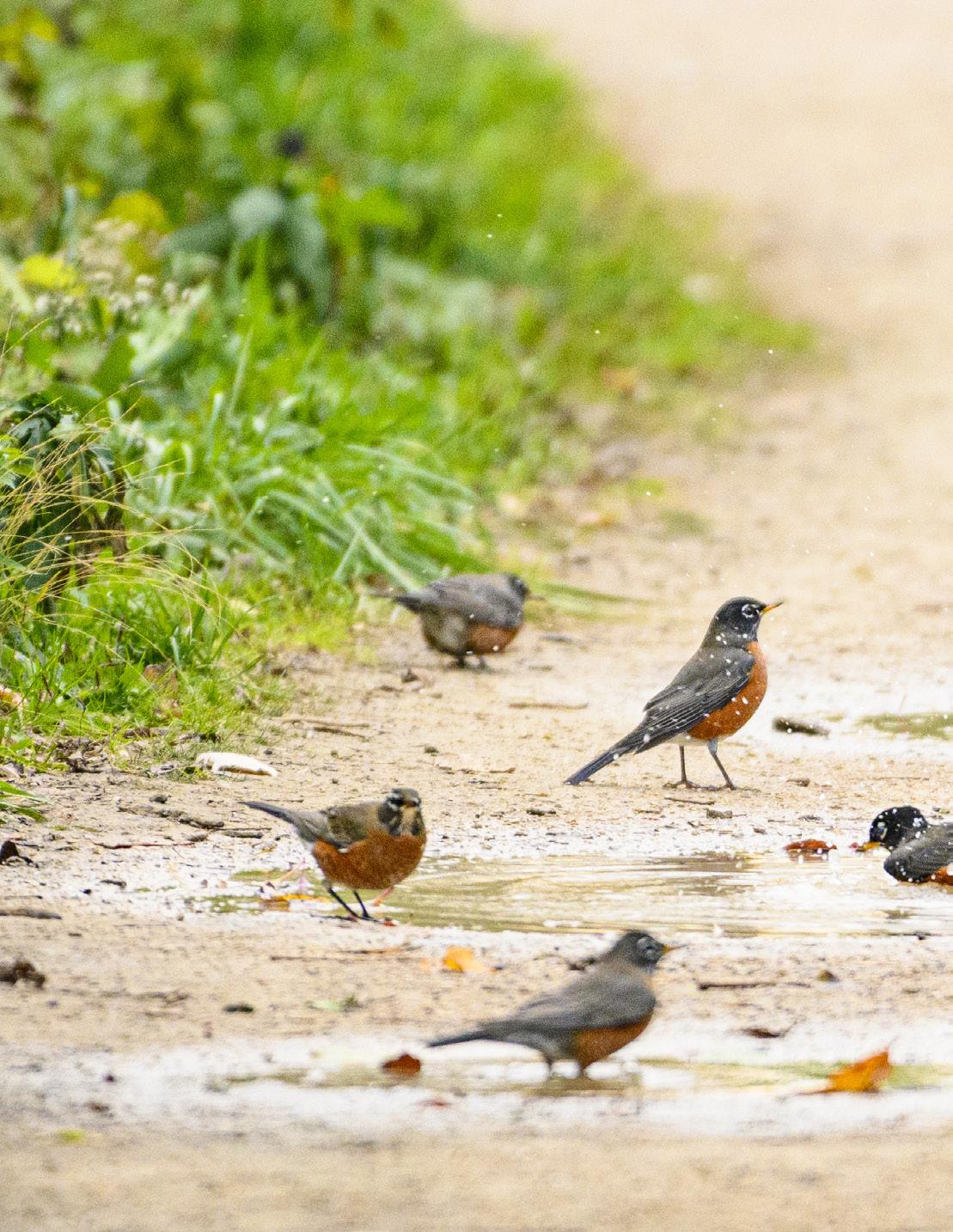
Feature
Sense of Place
 By Burnett D. Reed, Odyssey Project student
By Burnett D. Reed, Odyssey Project student
Taking a trip to this place, this place is filled with the wild sensations of nature. I step off the yellow school bus with the hopes of feeling the great breeze that nature politely offers up free of charge. I step off onto the sidewalk, weary of what I will see. I’d love to see the attraction sites, the trails, the different birds, the things the nature reserve has to offer. I take my first step off and immediately see multiple people, jogging with sweat trembling down their faces as if they’ve run miles. As I calmly walked as a wandering scholar to a wooden fence which I could see was the entrance. As I approached this fence I saw gravel on the trailway which I assumed guides us on our tour throughout the picnic point. I hear birds singing as they were happy to have company at they’re home. I start to whistle a tone to mimic the birds underline singing. I head on my adventure through the gravel and up the trail. I notice fire pits, fire wood, and different things stationed in this reserve. These essentials are well implemented into the park to compliment families, tourists, locals, animals and nature in all. We walk vividly side by side letting the breeze cool our skins, calm our bodies and take over our minds. I start to let my mind wonder and let my body absorb the natural sunlight given to us. I smell a body of water, Where is it? I walked further and noticed we were surrounded by lake mendota. I can fish here, I can swim here or just dangle our feet over the ledge and let the therapeutic sensation of the water calmly russell between my feet. I hear woodpeckers nodding away at the trees as if they haven’t eaten in weeks. I see attractions that would make me want to have a life out in the woods living like a caveman. It resonates so well with me because I’ve always wanted to live in a place like this. I feel that if you can make a home out of a home that life would be more inexpensive for most folks. This place sat so well with me, with the many sitting sites, many fire pits, many backdrops for pictures and just overall just a great nature reserve that compliments many different generations. I love the fact that it was kept up for so many years. You can see the beautiful birds non stop, butterflies non-stop flying by to say hello, the fish even stop up to say hello. So being able to enjoy this location and relax while enjoying it always helps.
At the Spring 2023 Odyssey graduation celebration, Reed was awarded the Lisa Munro Two-Generation Scholarship, which provides Odyssey alumni with a scholarship for both themselves and their child or grandchild.
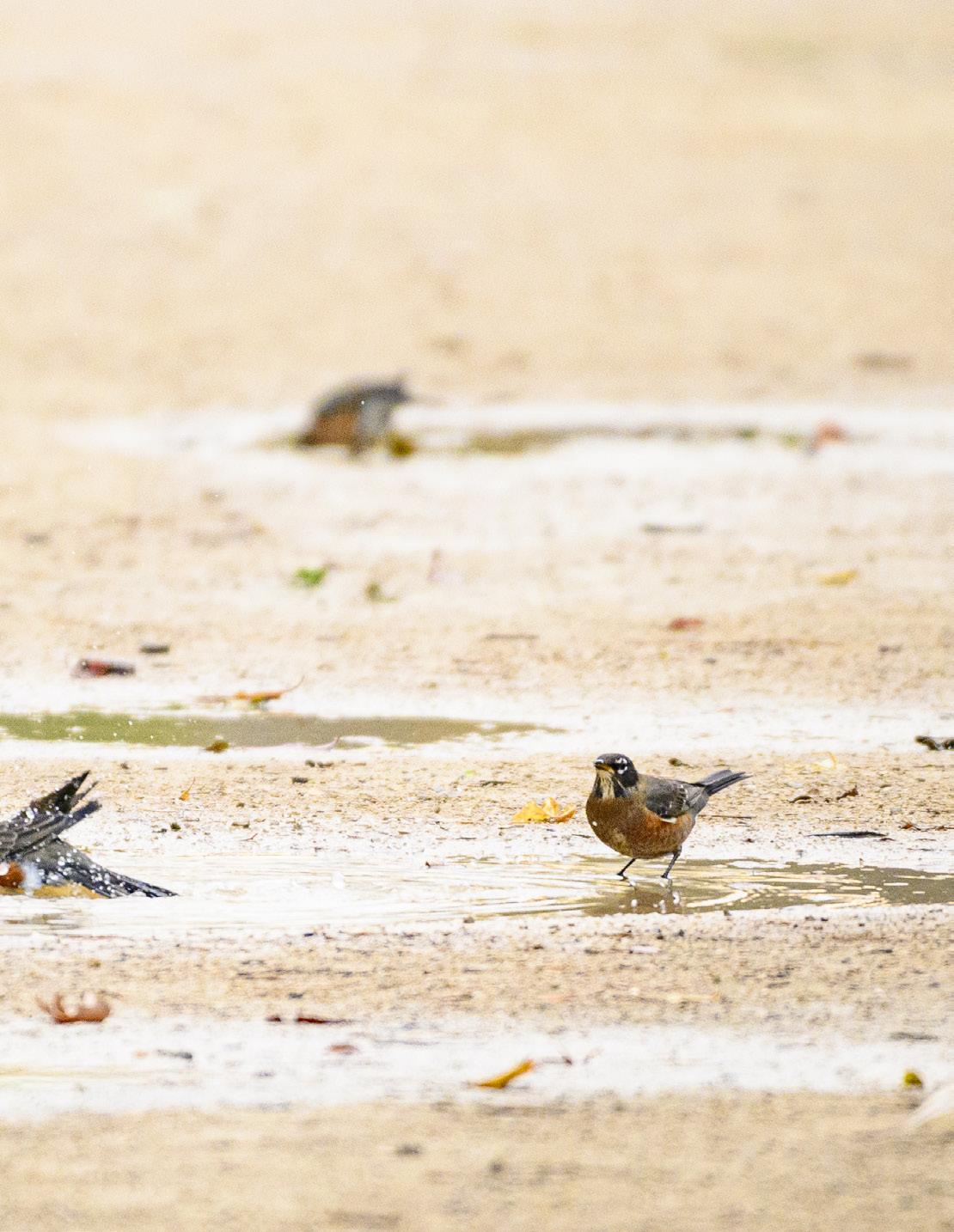
Feature
Hands-On Watershed Management
Nelson graduate students shared research on watershed management with Wisconsin’s Koshkonong Creek.
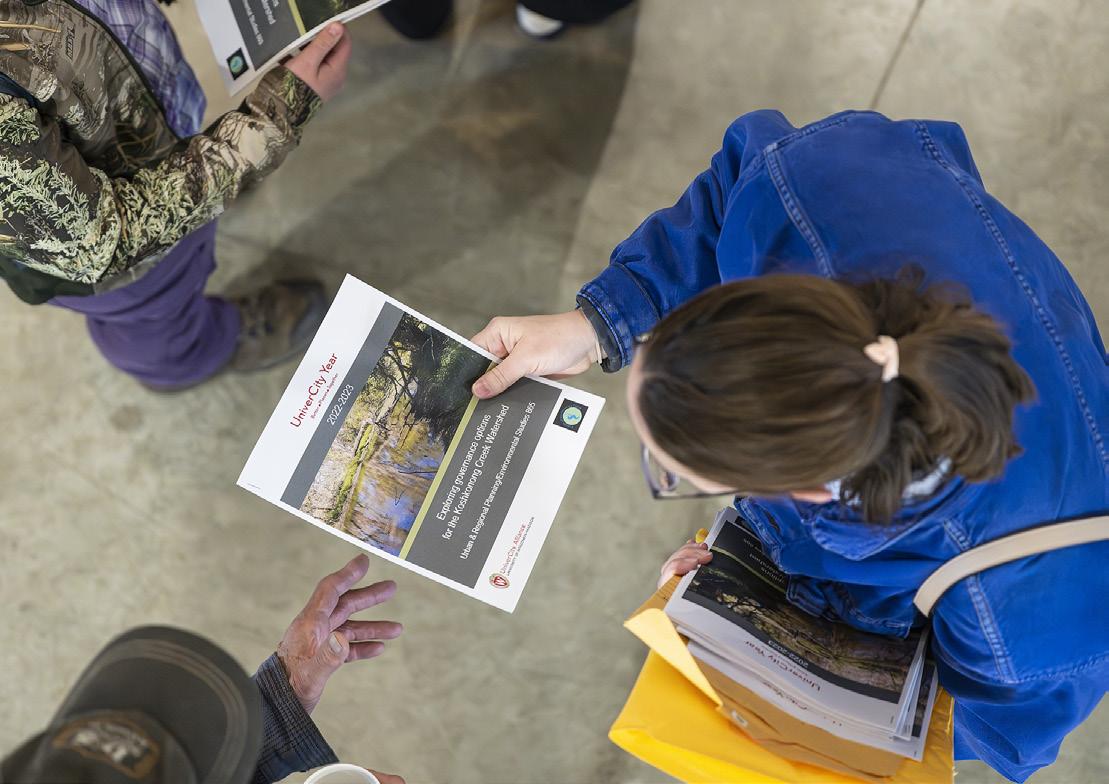 By Abigail Becker, UniverCity Alliance
By Abigail Becker, UniverCity Alliance
Determined to remove a log from a large pile, several Nelson Institute water resources management students attempted to pull on a system of connected several ropes by leveraging their bodyweight backwards across a field at Badger Farms in Deerfield.
“You don’t think that just tying a rope around the log and yanking on it is going to do much, especially for me who’s barely over five feet tall,” said Hannah Agner, a water resources management (WRM) student.
But the log slowly creaked its way out of the stack and was met with cheers when it finally broke free.
With the guidance of experienced water trail volunteers from Capitol Water Trails, Maunesha River Alliance, and Friends of Koshkonong Creek, the students were practicing different strategies that can be used to clear
blocked waterways during a Wisconsin Water Trail Development 101 seminar on April 29.
“They’ve come up with a pretty unique and interesting method of removing stream obstructions, so it was interesting to be able to pull on that and actually move the log out of it using the techniques that they’ve developed,” Agner said.
This was also the WRM students’ first time seeing the land they had been researching for the past semester. “Because we’ve just been studying this creek, we haven’t actually gotten to go out and do any type of field work,” WRM student Colleen Dickey said. “To actually be here is very motivating. It’s giving me the bigger picture that I need.”
During their two-year graduate program, the students
8 June 2023 Feature
Abby Becker, senior associate for communications and outreach with UniverCity Alliance, hands out a informational materials during an educational event for the Koshkonong Creek Watershed held at Badger Farms in Deerfield, Wisconsin. Photos by Bryce Richter / UW–Madison (8)
are partnering with the Friends of Koshkonong Creek and Badger Farms through UniverCity Year (UCY), which is the hallmark program of UniverCity Alliance (UCA).
From 2021–24, a collaborative that includes the city of Sun Prairie, towns of Deerfield and Cottage Grove, and Friends of Koshkonong Creek, with support from Badger Farms, partnered with UCY to work toward a healthier creek that can support a variety of wildlife and human activities for generations to come.
The April 29 event drew participants from the community, including nearby property owners, nonprofit volunteers, and interested residents. Representing UW–Madison were Ken Genskow, a professor of planning and landscape architecture and Division of Extension statewide specialist, and Ed Boswell, a teaching faculty member in GIS and geodesign.
Prior to the demonstrations, the audience heard from Capitol Water Trails’ Steve Falter on best practices for clearing waterways, safety tips, and rights of water users and land owners.
Genskow and PhD student Andrew Hillman shared the results of a study exploring governance options for the Koshkonong Creek Watershed, which resulted from a class taught by Genskow called Water Resources, Institutions, and Policies.

“As an ambassador of UW–Madison, we don’t think we know all the answers,” said UCA managing director Gavin Luter, addressing the community members who attended the event. “We want to learn from you as the experts on Koshkonong Creek.”
Genskow said the students have benefited from hearing directly from individuals and organizations who care about improving the quality of the creek, public access to it, and recreational opportunities on the waterway.
“As an instructor, it’s helpful to have real, unresolved challenges that emphasize the lessons discussed in class and published literature,” Genskow said. “Projects like this one help keep our educational experiences grounded and raise all sorts of applied research questions for the university to explore in partnership with community members.”
Attendees read over an informational handout with a QR code to download an app that allows users to report obstructions in the Koshkonong Creek.

Gavin Luter, managing director for UniverCIty Alliance at the University of Wisconsin–Madison, speaks during the event.
Boswell showed participants how to use an interactive website to report situations, like downed trees or other blockages, along the creek. These projects align with the Department of Planning and Landscape Architecture’s Geodesign Collaborative that provides digital tools to engage stakeholders and assist communities with planning and design challenges.
June 2023 9 Feature
“Being in the community is invaluable. Being in this space, you learn way more than you can on your own.”
— Colleen Dickey
Boswell said the event fostered interaction between the students and community partners with varying interests, from landowners who want to recover flooded farmland to people interested in developing innovative watershed governance structures. He’s already seeing the students’ appreciation for these different perspectives reflected in group discussions.


“Students choose programs like the MS in water resources management at UW–Madison because they want to make a difference,” Boswell said. “Community-based projects provide amazing opportunities for students to apply their skill sets and interests toward solving complex problems while developing empathy for diverse stakeholder perspectives.”
Agner said making those connections was the most important part of the event. “That can really help us in the early stages,” she elaborated, “to figure out where we want to take this project and what could actually be of use to them, rather than just us writing a report that’s going to get dusty on the shelf.”
This summer, the WRM students will be conducting field work, communicating with neighbors about the issues affecting Koshkonong Creek, and investigating the waterway’s hydrology to see how incorporating wetlands might address flooding issues. This research will inform a watershed management plan.

10 June 2023 Feature
Steve Falter, founder of Capitol Water Trails, speaks during the educational event.
“Projects like this one help keep our educational experiences grounded and raise all sorts of applied research questions for the university to explore in partnership with community members.”
— Ken Genskow
Heidi Putnam, who is pursuing dual master’s degrees in WRM and urban and regional planning, emphasized the importance of gathering information from those closest to the issue.

“You can have the best plan or idea in the world, but if you haven’t talked to someone that actually has lived experience in that area, it’s really hard to make that connection, to understand [if] this validates or invalidates our ideas or opinions about what might work for a place,” Putnam said. “If you aren’t having a direct conversation from the beginning, you’re not going to have a successful project.”
Both Dickey and Putnam have experience with UCY collaborations. While an undergraduate student, Dickey worked on a project addressing water quality in Pepin County. Putnam recently partnered with Polk County during Fall 2022 as part of her urban and regional planning degree.
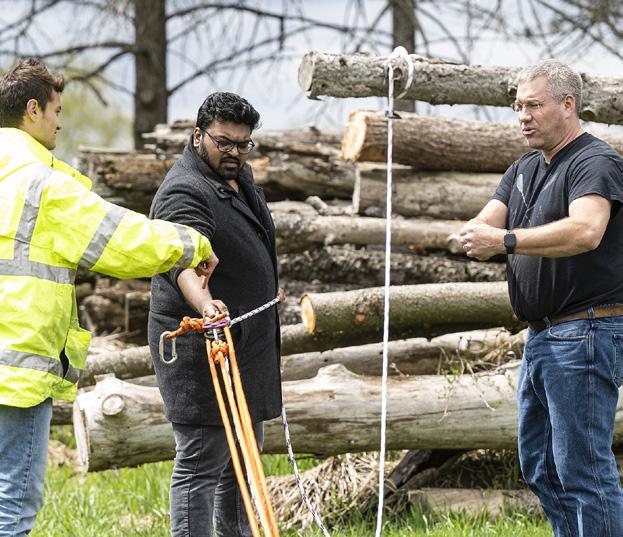
These experiences provide the opportunity for students to connect with community partners across Wisconsin and put the skills they learn in the classroom into practice. It also reinforces the importance of building relationships. “Being in the community is invaluable,” Dickey said. “You can’t read this online. Being in this space, you learn way more than you can on your own.”

June 2023 11 Feature
Left: Ed Boswell, teaching faculty with the Department of Planning and Landscape Architecture at the University of Wisconsin–Madison. Middle: Terry Bradshaw (left), demonstrates a rope technique with UW–Madison student Hannah Agner (right). Right: Bradshaw (right), with UW–Madison students Nicholas LaBracke (left) and Alan John Idiculla (center).
Terry Bradshaw, president of the Menasha River Alliance, gives a rope technique demonstration during the educational event.
Climate Effects on Tourism
Changing seasons are impacting tourism and outdoor recreation in Wisconsin.
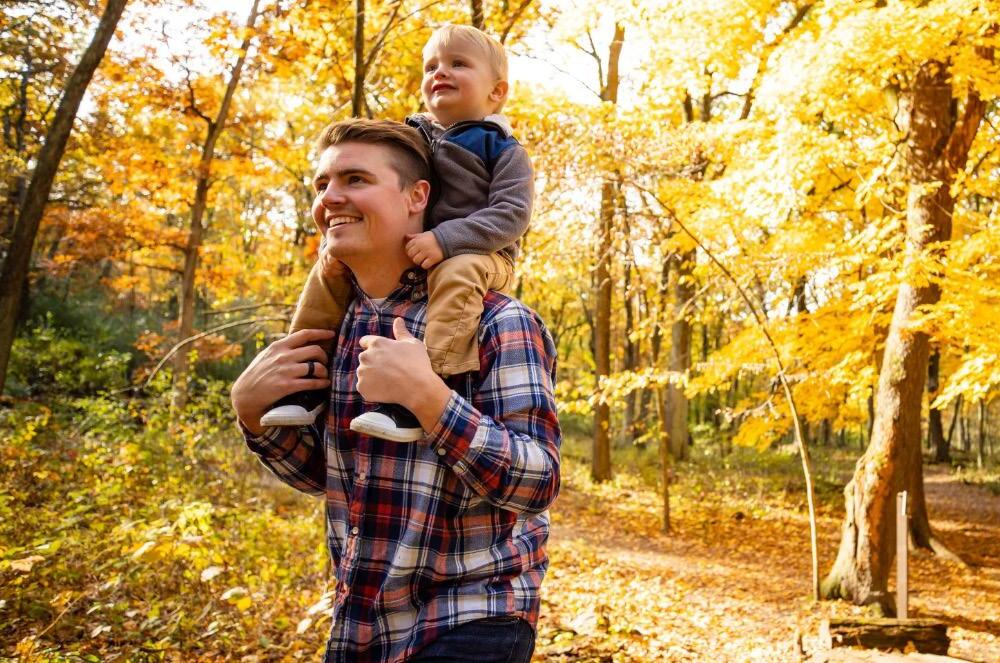 By Dea Larsen Converse, Wisconsin Initiative on Climate Change Impact
By Dea Larsen Converse, Wisconsin Initiative on Climate Change Impact
Tourism is one of the largest economic drivers in Wisconsin, and outdoor recreation across all four seasons are the basis for many tourist activities. As the climate continues to warm, rising temperatures are changing and shifting the seasons for outdoor pursuits according to the most recent report from the Wisconsin Initiative on Climate Change Impacts (WICCI). The last two decades have been the warmest on record in Wisconsin, and the past decade has been the wettest.
Warming temperatures are lengthening the season for warm weather recreational activities in Wisconsin, giving the state a competitive advantage compared to places that can become uncomfortably hot during the warm seasons. Extreme heat, however, could make events held in the middle of the summer risky for vulnerable populations, particularly in urban areas. Wisconsin’s fall color season could also lengthen in the future as the climate warms; however, extreme heat events and unpredictable precipitation levels could impact both the length and intensity of the state’s fall color touring opportunities. Wisconsin’s winter recreation season is shortening as warmer temperatures reduce
snowfall, snowpack, and ice cover on lakes. Migration patterns and habitat availability are also changing for many species as the seasons shift, impacting fishing, hunting, and wildlife watching, a major driver of Wisconsin’s tourism economy.
Severe storms and rainfall are also becoming more frequent and could endanger public safety, increase event costs and maintenance, and make recreational areas inaccessible. Severe storms also contribute to more water quality issues, including more frequent and severe harmful algal blooms in lakes and beaches.
But there is hope. Planning ahead for future climate impacts will be important to ensure Wisconsin’s tourism industry remains strong. The WICCI Tourism and Outdoor Recreation Working Group recommends that communities diversify tourism opportunities, enhance emergency preparedness for extreme weather, enhance public safety measures, adjust recreational trails to protect access, restore wildlife habitat, and take steps to reduce the risk of harmful algal blooms. There’s hope for the future, but it’s up to us.
12 June 2023 Feature
Photos by Travel Wisconsin (3)
Support WICCI
The Wisconsin Initiative on Climate Change Impacts (WICCI) is a statewide collaboration of scientists and stakeholders formed as a partnership between UW–Madison’s Nelson Institute for Environmental Studies and the Wisconsin Department of Natural Resources. WICCI’s goals are to evaluate climate change impacts on Wisconsin and foster solutions. Gifts to the WICCI Program Fund provide general, discretionary program support and enhance and expand WICCI’s teaching, research, and public service roles. Gifts also support partnership-building activities, including faculty, staff, and student recruitment, retention, and morale.
This article is part of a series highlighting the contribution from each WICCI Working Group for the 2021 WICCI Assessment Report.
Tourism and Outdoor Recreation Working Group




Climate Impacts to Tourism and Outdoor Recreation in Bayfield, Wisconsin Reflections on Climate Change and Tourism and Outdoor Recreation

June 2023 13 Feature
Do Biofuels Threaten Endangered Wildlife?
By Chelsea Rademacher
Ripple effects. Chain of events. Slippery slope. No matter how you frame it, it’s no secret that policies — however well intentioned — can have unintended consequences. New, first-of-its-kind research from the Nelson Institute for Environmental Studies investigated the connections between biofuels and threatened/endangered species across the U.S. and found that the federal mandate for corn ethanol production is likely jeopardizing imperiled wildlife.
The work, published in the March issue of the peer-reviewed journal Biological Conservation, is the first scientific assessment to establish the connection between renewable fuels policy, the conversion of land to grow biofuel crops, and adverse impacts to critical habitat of threatened and endangered species. “It’s not surprising that vulnerable wildlife are at risk, given what we know about the impacts of corn ethanol production,” says Tyler Lark, the paper’s author. “What’s more shocking is that we’re 15 years into our current biofuels policy, and there’s been little to no research on these interactions.”

The policy in question is the Renewable Fuel Standard (RFS) which, created in 2007, requires that all U.S.-sold transportation fuel include a minimum volume of renewable fuels. Thus far, those renewable fuels have come largely from corn-based ethanol — whose production can consume land otherwise used for conservation, impair water quality, and even increase greenhouse gas emissions.

14 June 2023
“Fortunately, all the tools and practices that we need to mitigate these negative effects and improve wildlife habitat already exist. We just need to act.”
FACULTY | STAFF IMPACT
— Tyler Lark
Corn ethanol production may be harming the habitats of endangered species, but there are readily available solutions.
Photos by Tyler Lark (3)
Lark, along with the Nelson Institute’s Holly Gibbs, previously contributed to a multiyear, comprehensive study on the environmental outcomes of corn ethanol. Published in early 2022, the study found that the RFS both stimulated the conversion of millions of acres of grasslands to cropland and intensified the production of corn on existing cropland. After the study concluded, Lark was curious: How has this boom in corn production affected critical wildlife habitat?
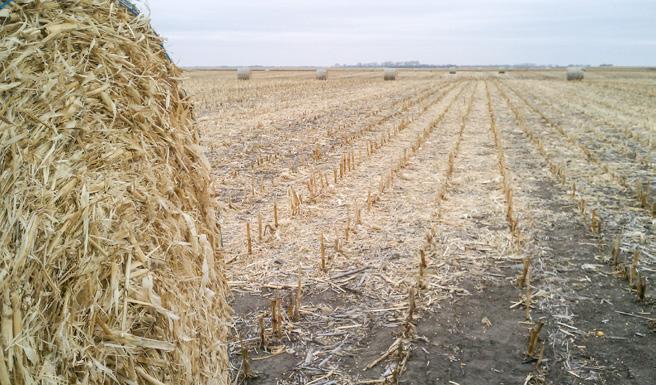
ourselves the opportunity to mitigate those impacts.”

Identifying the issue is the first step, Lark explains, but it’s vital that we don’t stop there. “There are simple solutions available right now to reduce or even reverse the impacts of bioenergy policy on imperiled wildlife.” For example, shifting biofuel dependence from corn to native and perennial plants — things like switchgrass, mixed prairie grasses, or woody coppice plants — could significantly reduce negative impacts, remediate harm from past land use changes, and even aid the recovery of threatened and endangered species. And if existing bioenergy croplands incorporated the use of cover crops and other conservation practices, it could better support wildlife and benefit land, water, and environmental quality at large.
Since 1973, the Endangered Species Act (ESA) has established a framework for protecting imperiled wildlife and conserving their habitats. Lark’s analysis identified a strong likelihood for interaction between the ESA and the RFS, and for the massive conversion of grassland to cropland instigated by corn ethanol to adversely affected imperiled species. “Just because there’s no way to say, ‘This policy impaired this individual animal’s survival or recovery,’ doesn’t mean these wildlife and their habitats aren’t affected,’” says Lark. What we can see, for example, is how corn ethanol production increases runoff and nutrient pollution in waterways, which degrades nearby habitats for aquatic species that rely on clean water. On the Venn diagram of landscape locations, many of the areas most affected by corn production are also the habitats of endangered species.
“The analysis shows that the U.S. Environmental Protection Agency should consult the federal wildlife agencies and consider potential impacts on endangered species when implementing renewable fuel policy,” Lark explains. “We need to look closer at these interactions. Only good can come of it. If we consider the potential interactions, then we at least give
Beyond implementing existing, proven mitigation methods, Lark hopes that the study sparks larger, more inclusive conversations when it comes to environmental policymaking. “One simple outcome that could actually have an impact is to have the federal wildlife agencies that support imperiled species weigh in. There are other studies that show that just the process of engaging those experts on policy and species interactions has led to meaningful conservation outcomes,” Lark says. “Fortunately, all the tools and practices that we need to mitigate these negative effects and improve wildlife habitat already exist. We just need to act.”
June 2023 15 FACULTY | STAFF IMPACT
Corn ethanol — made at refineries like this one in Minnesota — has driven land-use changes and crop choices that have resulted in carbon emissions negating any climate benefits from replacing gasoline with ethanol.
The amount of agricultural land that is used exclusively to grow corn for ethanol plants continues to grow.
Farmers’ Markets as Community Builders
Survey research shows how local food markets promote communication that builds civic engagement.
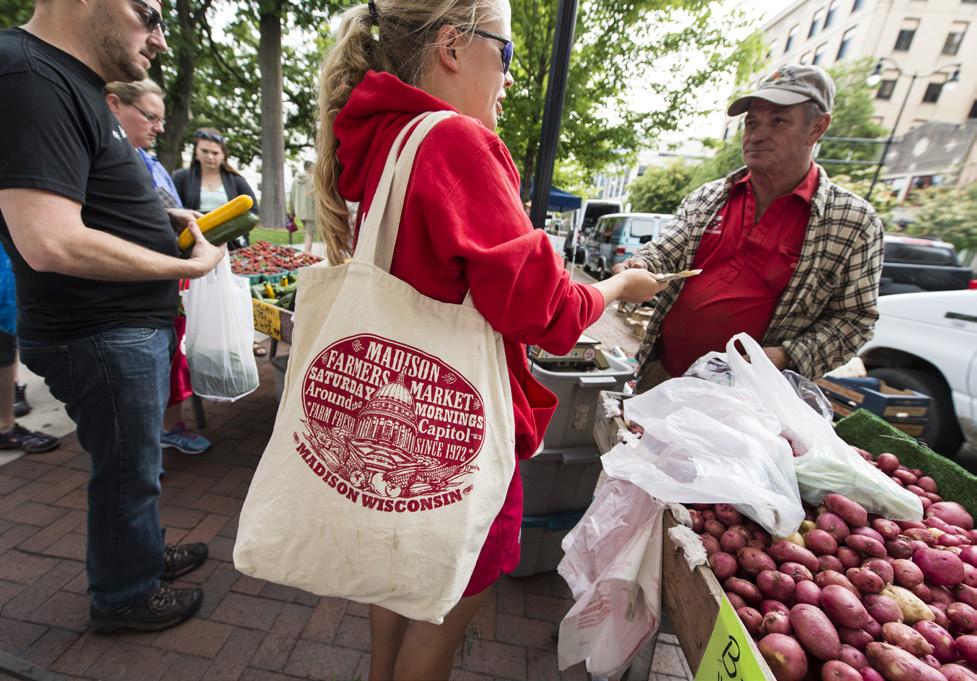 By Jocelyn Cao
By Jocelyn Cao
It’s a Saturday morning at the farmers’ market. You check in with the grower at your favorite tomato stand, stop to enjoy the folk music streaming from the plaza, and then chat with the flower vendor about joining next week’s blood drive. It may feel like a regular visit to the market — a little socializing, a little entertainment, a little food — but you might not realize you’re participating in something more.
“Farmers’ markets are more than just local outdoor grocery stores — they’re also places where you can register to vote, learn about community organizations, interact with neighbors and local farmers,” says Bret Shaw, an associate professor of life sciences communication, environmental communication specialist for the Division of Extension, and Nelson Institute faculty affiliate. “They are places where people can get in touch with their local food systems and build connections within their communities.”
These are just some of the features of farmers’ markets
that allow them to serve as centers of communication and enhance a community’s levels of civic engagement, according to new research by Shaw and alumna Laura Witzling. Using two Wisconsin-based surveys — one targeting farmers’ market leaders and the other distributed to Wisconsin residents — the study expands on previous work about the community benefits of farmers’ markets.
By buying locally grown food and interacting with vendors at farmers’ markets, community members participate in “civic agriculture,” which supports a community’s economic and social development. Other forms of civic agriculture include community-supported farms, urban community farms, and farm-to- school programs. Witzling and Shaw’s survey results reveal that farmers’ markets bridge the gap between civic agriculture and civic engagement by acting as communication infrastructures.
Communication infrastructures are networks of communicators — community members, organizations,
16 June 2023
FACULTY | STAFF IMPACT
Patrons shop the Dane County Farmers’ Market on a spring morning. Photo by Jeff Miller / UW–Madison
and local media. A strong communication infrastructure can facilitate civic engagement because it helps community members connect and address local issues.
Witzling and Shaw’s work shows that farmers’ markets possess the ability to act as communication infrastructures, and, in turn, promote civic engagement. In their study, more than half of the Wisconsin farmers’ markets noted existing partnerships with local media, with high percentages also working directly with many types of organizations. These relationships allow farmers’ markets to amplify community stories and connect residents to other community stakeholders, such as schools, local government, chambers of commerce, and nonprofits.
Additionally, farmers’ markets act as communication infrastructures by supporting social interaction through amenities, such as music and seating. They also work to make themselves accessible financially: many farmers’ markets accept electronic benefits transfer cards, which allow Supplemental Nutrition Assistance Program participants to put federal benefits toward the purchase of healthy foods.
So, taken together, what do these findings mean?
“Civic engagement typically means being active in your community by voting, volunteering, or participating in community meetings,” says Witzling, who is currently working as a consultant for the national Farmers Market Coalition. “But participating at farmers’ markets is another great way to make your community stronger.”
Now that their work has shown the value of farmers’ markets in Wisconsin, Witzling and Shaw hope to spread the word about how these markets foster communication and civic engagement in other places.
“Farmers’ markets are valuable community assets as they can bring together people that come from different backgrounds for various issues of shared importance,” Shaw says. “So we hope to expand on our successes in Wisconsin and do the same thing at a more national level.”
This story was originally published by Grow , the triannual magazine of the College of Agricultural and Life Sciences.

June 2023 17 FACULTY | STAFF IMPACT
“Farmers’ markets are valuable community assets as they can bring together people that come from different backgrounds for various issues of shared importance.”
— Bret Shaw
From the Office of Sustainability
A monthly update from faculty, staff, and students in the Office of Sustainability – Education and Research. This month’s column is from graduate project assistant Audrey Stanton.

Surrounded by raging rivers and the remarkable Rocky Mountains, my upbringing in Montana fostered a love for the natural world. It was an easy choice to pursue environmental science for my undergraduate degree at Cornell University. I was eager to be a part of efforts to address climate change, one of the most wicked problems facing the world.
Along the way, I realized that environmental stewardship and spending time outdoors were not always enough to encourage others to protect our natural resources. Searching for something broader and more inclusive than environmentalism, I found sustainability. And when I couldn’t choose between my passions for sustainability and education to guide my graduate school search, I found an interdisciplinary home at the Nelson Institute.
In recent years, I completed an environment and resources master’s with Professor Emerita Cathy Middlecamp. In collaboration with Dr. Middlecamp and Nelson Institute graduate Mackenzie Thelen, we created the Campus Sustainability Map. Now, I’m an environment and resources PhD student with Andrea Hicks. My research focuses on campus sustainability and sustainability education. Current research projects draw upon the fields of chemistry, industrial ecology, and urban planning. Since UW–Madison is the size of a small city, it serves as a fantastic microcosm for resource use and sustainability initiatives.
I also work as a graduate project assistant with the Office of Sustainability. I support the student intern program managed by Tim Lindstrom and the Green Fund managed by Ian Aley. A distinct component of what makes my work so rewarding are the dedicated and thoughtful undergraduate students that I teach and support. These students address sustainability with their personal strengths and skills. While I work to inspire them to remain engaged and enthusiastic, the inspiration goes both ways.
Higher education has a major role to play in addressing resource use and implementing sustainability practices. I look forward to advancing these efforts with the dedicated students, staff, and faculty working at UW–Madison and beyond. Feel free to reach out to me; I’d love to connect about campus sustainability.
18 June 2023 FACULTY | STAFF IMPACT
It has been a great year for the Center for Ecology and the Environment (CEE)!
We held a wonderful series of symposia (fall and spring) that were well attended, and we provided a broad range of events for undergraduate and graduate student engagement in the ecological research community.
Highlights of our work include:

• An undergraduate job fair for ecological research on and off campus
• Graduate student recruitment and cohort-building events
• Leadership opportunities for graduate students, including a graduate student symposium in the spring that showcases recent grads and undergraduate research
• Events that highlight new faculty members and help build collaborations across campus
I want to thank our executive committee members for their hard work this year: Aldo Arellano, Jamie Botsch, Roberto Carrera-Martínez, James Crall, Zac Freedman, Sara Hotchkiss, Dana Johnson, Carson Keller, Cooper Rosin, Wendy Turner, Jesse Weber, Kyle Webert, and Benjamin Zuckerberg.
As we move into the next few years, we hope to continue strengthening our community by broadening our interaction with interdisciplinary units across campus and increasing community engagement outside of the UW, with govern-
Director’s Cut
ment, tribal, and non-profit stakeholders. A particular goal is to strengthen programming that focuses on conservation biology and improves interdisciplinary research in the natural and social sciences at UW–Madison. We also hope to develop a small grants program to support graduate student research and expand our undergraduate club (“WILD-SEEDS,” or Wisconsin Idea Leadership Development in Ecology Education, Diversity and Sustainability). These activities will be led by our incoming director, Benjamin Zuckerberg (Forest and Wildlife Ecology), an internationally-recognized expert in climate change ecology and wildlife conservation.
Sean Schoville Out-Going Director, Center for Ecology and the Environment
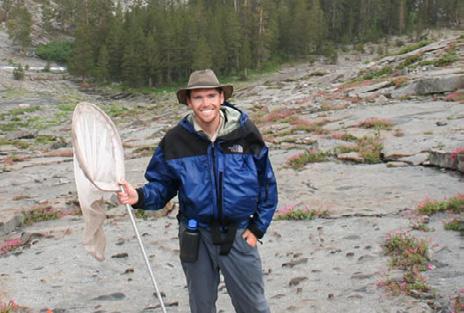

June 2023 19 FRONT AND CENTER
A quarterly update from Sean Schoville, director of the Center for Ecology and the Environment.
Can Goats Take a Bite out of Invasive Plants?

CALS scientists look to ruminant grazing as a potential method for nonnative shrub control in oak woodlands.
By Caroline Schneider, College of Agricultural and Life Sciences
On a walk through the woods in Wisconsin, you might expect to see a few squirrels, a variety of birds, and maybe even a whitetail deer. Goats, on the other hand, don’t make that list. But goats might be spotted among the trees more often if ongoing research in the College of Agricultural and Life Sciences shows they’re useful for controlling invasive species.
Invasive shrubs pose problems for wooded areas, whether they’re used for agricultural production or managed as natural areas. In cases of silvopasture, where trees and grazing livestock are integrated, the shrubs create a dense canopy that prevents forage growth. The shrubs also outcompete native species, reduce wildlife habitat, and change the soil’s ability to absorb water, all of which can hinder the restoration of woodlands as natural areas.
For these reasons, Stefania Cartoni Casamitjana and Mark Renz are looking at the grazing prowess of goats as one possible method for controlling invasive shrubs in oak woodlands. They’re conducting research at two southern Wisconsin locations. One is a degraded oak woodland in need of restoration at the American Family Insurance headquarters in Sun Prairie. The other, situated 30 miles west in Prairie du Sac, is a plot slated for conversion to silvopasture.
“Woody shrubs likely have a greater impact in Wisconsin than all other invasive species combined because they completely dominate wooded systems, transform the plant and animal communities, and change ecosystem processes that Wisconsinites rely on,” says Renz, a faculty affiliate of the Nelson Institute’s Center for Ecology and the Environment and professor and extension specialist in the Department of Agronomy.
“A healthy oak savannah should be pretty open and allow a lot of light through,” explains Cartoni Casamitjana, a doctoral student in agronomy. “But there’s no open space in our sites anymore, and they’re invaded by mostly buckthorn and honeysuckle.”
To control these nonnative shrubs, the team is exploring the relative effectiveness of several techniques. In addition to goat grazing, they’re studying two widely used methods: herbicides and large mowers that can remove the aboveground portion of the shrubs. Goats, however, may bring special abilities.
“A unique thing about goats is they will preferentially feed on woody species, so their impact is more on the shrubs,” says Renz.
“Also, goats are useful in areas where you can’t go in with machinery or you don’t want
FRONT AND CENTER
to go in with herbicides,” adds Cartoni Casamitjana. “If you have steep terrain, for example, you can’t go in with machinery, but goats are very able to take that on.”

The researchers are in the early stages of a multiyear effort in which they will apply various treatments. In the first year, the team mowed, introduced goats, or left the woodlands untouched. In the second year, each of the first-year treatments will be split in two, with half treated with herbicide and the other half grazed by goats. To determine the effectiveness of each treatment, the researchers are measuring understory plants and the amount of light that can reach the forest floor.
In the first year of the study, the team saw immediate effects from both goat grazing and mowing, but the shrubs regrew as the season went on. By summer, the team saw no difference between the goat grazing areas and untreated woodland in terms of light interception, but the mowing treatment allowed more light to hit the forest floor. When surveying the plants to see how much vegetation remained and regrew, there was no difference in shrubs between the goat and mowing treatments and the area that was untreated.

“It’s not a surprise,” says Renz. “These are shrubs that have lived five to 50 years, probably. We knew we were going to need to do multiple years of management.”
Renz and Cartoni Casamitjana are also considering the expense associated with each treatment and what that means for farmers and landowners. “Cost of implementation of each of these techniques is very important,” explains Cartoni Casamitjana. “Yes, one method might be more effective, but if it’s many times more expensive, will anyone use it? We want to be able to give useful recommendations. That’s the goal.”
This story was originally published by Grow magazine.
June 2023 21 FRONT AND CENTER
A wooded test site in Sun Prairie, Wisconsin, before and after goats grazed on invasive shrubs. Photo courtesy of Stefania Cartoni Casamitjana (3)
Goats graze on invasive shrubs at a wooded test site in Sun Prairie.
“Woody shrubs likely have a greater impact in Wisconsin than all other invasive species combined.”
— Mark Renz
Nova Tebbe, a PhD student in the Center for Sustainability and the Global Environment, exemplifies the interdisciplinary research of the Nelson Institute. She describes her research as the intersection of climate change, health, equity, and policy. Tebbe discovered her passion for policy in an undergraduate philosophy class as she delved deep into political issues to understand their history and implications. This led her to complete a dual degree — a master’s of public health and a master’s of public administration — at UW–Madison; however, Tebbe didn’t feel that her education was finished.
“I felt if I didn’t go for a PhD, then a lot of that work and a lot of the questions I’d been asking would remain unanswered, and I don’t think my brain could handle that,” Tebbe said. It helped that Tebbe worked with her current PhD advisor, Professor Jonathan Patz, during her master of public health coursework, and he encouraged her to pursue a PhD.
One of Tebbe’s recent research projects was a policy analysis submitted on behalf of the Paris Agreement. In 2015, this landmark climate agreement was signed at the United Nations Climate Change Conference. The agreement aims to hold climate warming well under 2°C above preindustrial levels, and to achieve
Taking Stock of the United Nations Paris Agreement
Nelson PhD student Nova Tebbe policy analysis reaches the global stage.
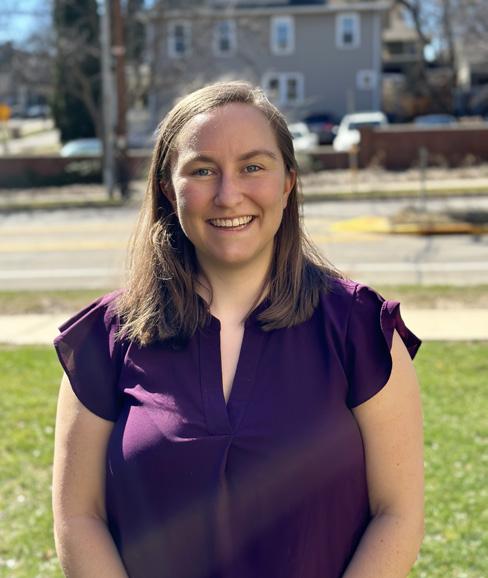 By Michael Kamp, Energy Policy and Analysis
By Michael Kamp, Energy Policy and Analysis
this, individual countries establish their own greenhouse gas reduction goals called Nationally Determined Contributions.
The policy analysis submitted was for the Global Stocktake (GST). In short, the many submissions making up the GST evaluate the Paris Agreement. “The purpose is to take stock of how well countries were doing on those targets in the Paris Agreement every five years,” Tebbe explained. The GST takes two years to complete and began in 2021 instead of 2020 due to COVID-19.
The GST is extremely important because it allows observer organizations to provide input on successes and shortcomings of implementing the Paris Agreement. Across the globe, diverse environmental organizations and advocacy groups can apply for observer status with the United Nations to provide this feedback. “This is the first global stocktake, so we’re not entirely sure of the implications yet, but the opportunity is essential,” Tebbe said.
Additionally, the GST has an eye on the future. According to Tebbe, “The stocktake helps inform future [United Nations Climate Change conferences] as well, like what should be talked about, and what should be drafted in some of those initial texts.”
22 June 2023 STUDENT SNAPSHOT



STUDENT SNAPSHOT
“At the end of the day, we want to make an impact and make the connections between climate change, health, and equity really well known. That’s our overarching goal here.”
— Nova Tebbe
Above: Jonathan Patz and Tebbe traveled to the Consortium of Public Universities for Global Health, which was held back in-person for the first time this year. At right (2): In 2021, Tebbe attended the UN Climate Change Conference (COP 26) in Glasgow, Scotland. Photos courtesy of Nova Tebbe (7)
Tebbe led a team in conjunction with the Global Climate and Health Alliance (GHCA) to create a submission for the GST. Jess Beagley was instrumental from the GHCA side, and Tebbe also wanted to highlight the integral assistance of UW–Madison undergrad, Madison Xiong. Jonathan Patz’s group has a longstanding relationship with the GHCA, and with observer status, the GHCA can submit to the GST.
The submission itself focused on climate mitigation policies that also benefit health and equity. The health and equity benefits stemming from climate mitigation policies are commonly called co-benefits – a key area of research for the Patz group.
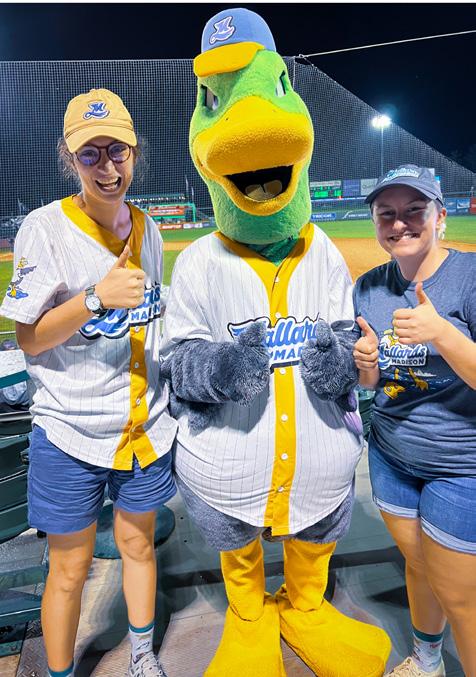
Tebbe said, “What makes our policy briefs unique is that we showcase [climate mitigation] policies that have health and equity co-benefits. We gave a submission to show there are policies that are positive for health, positive for equity, that have been happening on local levels of these countries, and we need to amplify that.”
The report focused on 15 climate mitigation policies spread across eight sectors, like energy and transportation. To choose the policies, the team completed a multi-goal policy analysis using specific criteria. Tebbe made these detailed criteria by extensively reviewing primary literature to measure the health and equity outcomes of policies. For the GST submission, there were five health goals and six equity goals used to assess policies. For example, one health goal is “to reduce premature mortality,” and one equity goal is “to improve community ownership.”
However, even with the criteria, narrowing down the policies was a formidable challenge. “When you think about mitigation policies, let’s say for the energy sector, there are tons of different policy options,” Tebbe said.
Despite the challenges, Tebbe feels proud and confident of their submission — in fact anyone can see their hard work. Tebbe encourages people to check out the submission because it’s public.

The report outlines that ambitious climate policies are: 1) needed; 2) provide health and equity co-benefits if done right; and 3) already being done on local levels.
Enabling fast and equitable fossil fuel phaseouts for electricity generation is a policy outlined in the submission. Phaseout plans for coal, natural gas, and oil need to account for equity concerns, such as providing
24 June 2023 STUDENT SNAPSHOT
Tebbe (right) and her family traveled to Colorado’s iconic Red Rocks Amphitheatre.
Tebbe (right) and her roommate (left) explored Madison’s sport scene at a Madison Mallards game.
reliable and affordable electricity, and engaging local communities. “We want to make sure that communities who are at the forefront and live near fossil fuel facilities are the first ones who are part of that phaseout because they’re experiencing the burden of those health risks,” Tebbe said. Burning coal, for instance, presents a serious health hazard as particulate matter enters deep into people’s lungs and can cause respiratory illnesses.
Now that the report has been submitted to the United Nations, Tebbe is preparing the research for a scientific publication so it’s seen by more people. “At the end of the day, we want to make an impact and make the connections between climate change, health, and equity really well known. That’s our overarching goal here,” Tebbe said.
Furthermore, Tebbe wants to make her criteria to analyze policies for equity and health benefits broadly available. “We want to get an expert opinion on those criteria and publish that as well so that the criteria can
be used by advocates, by anybody who wants to advocate for or analyze climate mitigation policies in health and equity,” Tebbe said.
Simply contributing to the GST was a special experience for Tebbe. “I would say as a PhD student, doing something at the United Nations level, is to me still unbelievable, and knowing that my work, that the research I’m doing is directly applied and organizations like the Global Climate Health Alliance value that work, to me is like a dream come true,” Tebbe said.
In the coming months, the United Nations will release a summary report of the submissions for the first GST. “Hopefully, our submission, in terms of health and equity, makes its way in [the summary report], but there are hundreds and hundreds of submissions,” Tebbe said.
Regardless of what appears in the official summary report, Tebbe and her team clearly showed the health and equity co-benefits of climate policies.
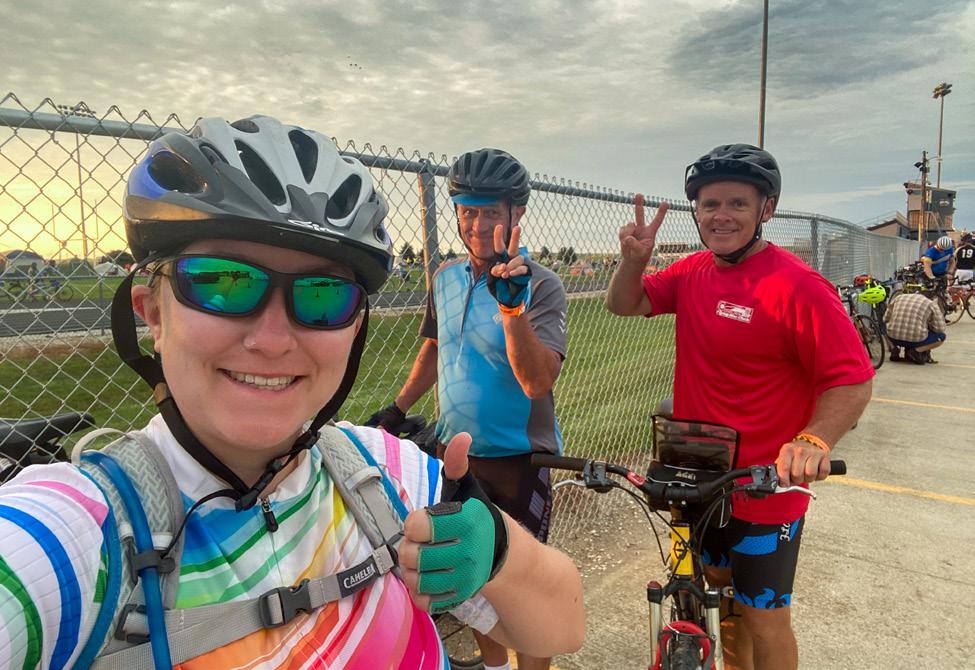
June 2023 25 STUDENT SNAPSHOT
When she’s not crafting public health policy, Tebbe likes to hit the road on her bike. She recently completed RAGBRAI, Register’s Annual Great Bicycle Ride Across Iowa.
Happy Cows are Safe Cows
Keeping cattle stress levels low through low-stress livestock handling techniques helps the herd in more ways than one.
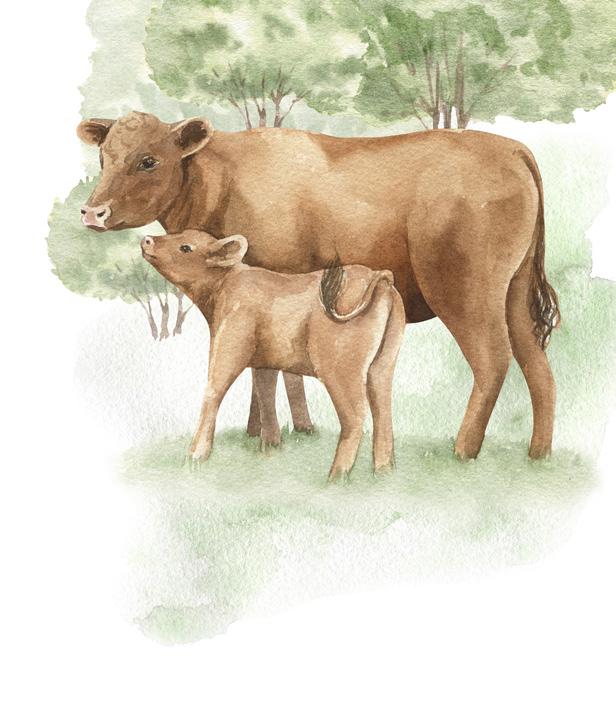 By Chelsea Rademacher
By Chelsea Rademacher
What happens to you when you’re stressed? Do your eating habits change? Maybe you exercise less, or maybe you avoid being around your friends and family. The same goes for cattle. This is not news: that stress negatively affects animals. But what is new are the results from a study measuring the effectiveness of low-stress predator deterrent techniques on large-scale cattle ranches.
The finding comes from a recent study coauthored by Naomi Louchouarn, a PhD candidate in the Nelson Institute’s environment and resources and researcher in the Carnivore Coexistence Lab; and her advisor, Adrian Treves, the lab’s founder. Treves’ lab has extensively researched various types of common predator deterrents, including fencing, lights, and flags, but for this study, Louchouarn and Treves investigated an age-old deterrent: range riders. “Cowboys or cowgirls,” defines Louchouarn.
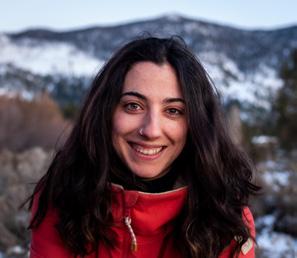
Range riding is a common practice on large ranches, like the one in Alberta, Canada, that the study utilized. “For people who don’t really know about ranching, like me when I started out, we kind of assume that there are always cowboys and people out there watching livestock,” Louchouarn explains. “But that’s not actually true.” Because the areas are so expansive, it’s common for animals to get released onto public lands in the summer to graze without supervision, then get picked up in the fall. For much of the last century, predators like wolves and bears have been scarce on these landscapes, so the summer drop-off system worked fine. But as predators return,
they find unsupervised livestock as an easy meal. Many organizations, including local and federal agencies, are now looking to hire range riders to supervise and protect livestock throughout the summer — under the assumption that range riding works. “Range riding has been in practice forever, because we know that there have been cowboys around forever,” she says. “No one had ever studied it with an experiment, and no one had ever taken the time to define it in an experimental way.”
So Louchouarn and Treves did just that. They tested if range riders are effective at deterring predators from attacking livestock, and if so, what they’re doing to be effective. “The reason that’s useful,” says Louchouarn, “is because then we can say whether this kind of range riding works or doesn’t to protect livestock.” And why that is useful — and what makes this study special — is that it gives scientists the first experimentally backed proof that range riding works, and a framework to conduct further experiments.
— Naomi Louchouarn
The answer to the first question — is range riding effective — was a resounding yes. “Before our experiment started, there had been lots of predator kills on livestock, at least multiples each year,” Louchouarn says. “During our study, there were none.” Through trail cameras, the team knew that predators were nearby, yet they weren’t coming near the livestock. “That tells us that this method is pretty effective.” Though these results were only observational, Louchouarn’s study set the stage to help
26 June 2023 STUDENT
SNAPSHOT
“If one of the first steps to coexisting with predators is happier livestock, then that’s a win-win.”
other researchers and organizations conduct more studies.
The type of range riding that they studied is called “low stress livestock handling” — in other words, deterrent techniques that cause less stress on the herd. Traditional forms of livestock handling — like being rounded up in a tight group — can cause a significant amount of stress on the herd and actually change the way they interact — which in turn makes them easier prey. For example, if the herd is kept in pens at high density, they start to associate being in a group with stress. “As soon as you release them out into the field,” says Louchouarn, “they scatter.” Easy prey. Low-stress handling, on the other hand, teaches them to associate herding with being safe.
their focus on the wellness of the herd. Beyond keeping the herd together, why is managing stress so important?
“Cows are so sensitive to stress,” Louchouarn explains. “When they’re stressed, they could get pneumonia or other diseases and die.” They also start their lives stressed, getting weaned from their mothers almost immediately. “A lot of calves die. We’re talking huge mortality rates, like 20 percent.” Although a higher-stress mitigation tactic might get rid of the predator, the stress of those methods is likely to cause cattle deaths anyway.
Now for question number two: what are range riders doing to keep the herd together, happy, and stress-free? It’s not chasing and circling like you might see in the hit TV series Yellowstone. “The rancher we worked with, Joe Engelhart” Louchouarn says, “he’s not afraid to take his time while he’s working his cows. When he’d move the herd, he’d honestly just get a couple cows up and get them moving. And then they would all sense that there was movement, and they would all just go, and then he would just watch them go.”

If that sounds pretty idyllic, it gets better. Another rancher, Whit Hibbard, who first taught Engelhart about low-stress livestock handling and has embraced the practice for decades, did some personal experimenting on calf wellness to reduce mortality rates. Louchouarn recounts the story with a smile: “Right after weaning, he started getting his calves up on this hill, then he would chase them loosely down the hill. And when they start to run down the hill, they get excited, and they start to play. And by the time they get to the bottom of the hill, they’re bucking and playing.” Hibbard saw his calf mortality rates drop from 20 percent to less than 1 percent — just from a healthy dose of playtime.
Then there are tactics like hunting predators which, research suggests, can actually reinforce predatory behavior. “If you kill a wolf pack in your area that’s been living there peacefully, instead of training these animals to not kill your livestock, you’re making space for new animals to come in who might kill your livestock,” Louchouarn says. Plus, if the range rider is focused on chasing down a predator, they leave the livestock exposed to other predators. “We want our riders focusing on handling domestic animals instead of the stealthy wild predators,” she adds.
So rather than keeping cattle in fences or hunting and killing predators, this method asks the range riders to keep

Although their initial findings are promising, Louchouarn and Treves hope that their study is the impetus for more, similar studies. “The big picture takeaway for me is that we are lacking research in how stress in our animals and the way that we handle our animals affects their ability to survive and thrive when they’re free ranging,” says Louchouarn. “If one of the first steps to coexisting with predators is happier livestock, then that’s a win-win.”

June 2023 27 STUDENT SNAPSHOT
Joe Engelhart (left), the ranch’s owner, rides alongside fellow rancher Roland Soppola. Photo courtesy of Naomi Louchouarn (4)
Left: Louchouarn in the field conducting research. Right: Though predators were identified on trail cameras throughout the study, no livestock deaths were reported.
Teaching the Colorado River Crisis
The Colorado River is in crisis, and two Nelson Institute students are helping share the facts.
 By Chelsea Rademacher
By Chelsea Rademacher
For 40 million Americans, the Colorado River is a life source. Stretching 1,450 miles from the Rocky Mountains to the Gulf of California, the river supplies drinking water, agricultural irrigation, and even electricity from its hydroelectric dams. But for the past few decades, the Colorado River has been under severe threat from both climate change and overuse.
28 June 2023 STUDENT SNAPSHOT
Low water levels along the Colorado River.
Fortunately, new educational information is available thanks in part to two Nelson Institute students: Ben Lebowitz, a master’s candidate in the environment and resources program, and Cyrus Gordon-Hill who graduated in May 2023 with an environmental studies certificate. Alongside UW emeritus professor Brad Barham and California-based freelance videographer Robert Marcos, the team developed the Colorado River Basin Project, a series of educational videos and modules designed to help instructors teach about the important water source, the challenges it faces, and the solutions that could save it.
“From the beginning of the project, our own narrative was ‘discovery,’” says Lebowitz. “By keeping our minds open to new perspectives and learning opportunities, we were able to build relationships while also building a story about what is going on in the Colorado River Basin.”
The project’s launch couldn’t have been timed better. In early April 2023, the Colorado River crisis reentered national media as the presidential administration proposed a first-of-its-kind change in how water from the river is allotted. The plan would reduce the water delivered to three key states — California, Arizona, and Nevada — evenly by up to 25 percent. One alternative proposal was to take no action, which would likely result in a “deadpool,” or when a reservoir drops so low it can no longer flow downstream. Another was to make cuts based on the
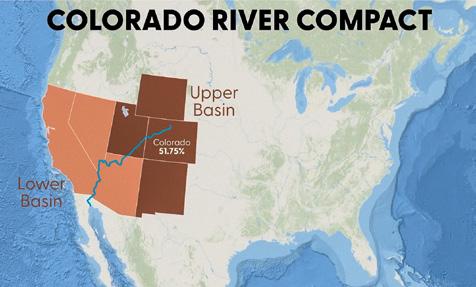

June 2023 29 STUDENT SNAPSHOT
“I hope these videos are a tenth as valuable to others as making them was to us. If so, they will be worth a lot.”
— Ben Lebowitz
The Colorado River Compact, originally dating back to 1922, divided the river to two basins. The Upper and Lower Basins established management frameworks and water allotments.
states’ water rights “seniority,” or those who have used water from the Colorado River the longest (in this case, California). That plan, however, would almost eliminate the drinking water carried to Phoenix and Tucson.
While the governmental arm focuses on temporary fixes for the present, Lebowitz, Gordon-Hill, and Barham have focused the Colorado River Basin Project on the future. “We could never have hoped to capture all of the issues present,” Lebowitz says, “but our project is an attempt to bring some of the biggest themes to light.” The project includes four modules, each tackling the Colorado River crisis from different lenses: an overview of the Colorado River and the key players who have shaped it; a historical look at the river, including tribal water rights; the economics of water, including agricultural and urban impacts; and finally, policy options to stop the crisis, from short-term conservation options to longer-term adaptive management practices.
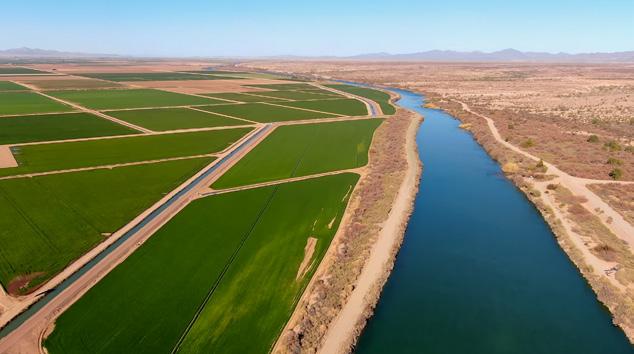

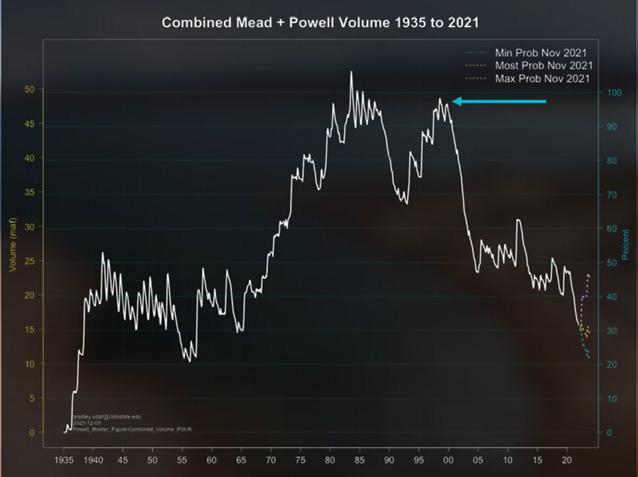
“What a remarkable ‘capstone’ project for my 35-year career at UW –Madison, traveling through the upper and lower basins of the Colorado River with our great team, learning from so many knowledgeable people, jumping into the Colorado’s tributaries, and puzzling over sustainable and equitable options for tribes, cities, rural communities,” Barham reflects.
“I am so grateful that we have had the opportunity to discuss, discover, and now share what we learned along the way. I hope these videos are a tenth as valuable to others as making them was to us. If so, they will be worth a lot.”
30 June 2023 STUDENT SNAPSHOT
A screenshot from one of the project’s videos shows the probability of water levels.
Stills from the project’s educational videos show the impacts of water diversion and over-irrigation on cropland loss.
Dylan Bizhikiins Jennings Appointed to Wisconsin Natural Resources Board
The two-time Nelson Institute alumnus will serve a six-year term starting in May 2023.
By Chelsea Rademacher

Nelson Institute alumnus Dylan Bizhikiins Jennings was recently appointed to the Wisconsin Natural Resources Board by Governor Tony Evers. Jennings, a member of the Ojibwe Marten clan, graduated from UW–Madison with a bachelor’s in environmental studies and master’s in environmental conservation. He is currently a HEAL Earth Partnership doctoral fellow on campus, and also serves as the associate director of the Sigurd Olson Environmental Institute at Northland College, a private, liberal arts college in Ashland, Wisconsin, that focuses on the environment and sustainability.
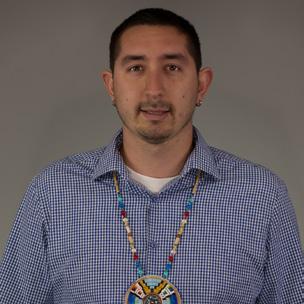
“Our Indigenous communities have longstanding environmental knowledge that I believe can help address some of the environmental issues we are encountering today,” says Jennings. “I look forward to working with the board and with the Wisconsin Department of Natural Resources.”
Jennings has been appointed to the board alongside Jim VandenBrook, a fellow UW alumnus and executive director of the Wisconsin Land and Water Conservation Association; and Paul Buhr, a veteran dairy farm owner and operator. Started in 1967, the Wisconsin Natural Resources Board sets policy for the Wisconsin Department of Natural Resources on topics like PFAS, wolf population management, and more. Board members, who serve six-year, staggered terms, are appointed by the governor and confirmed by the senate.
“I’m very proud to come from an extensive network of Nelson Institute staff, faculty, and alumni,” Jennings adds. “I intend to tap into all of these wonderful resources to better understand the issues and to help create policy.”
Read more about Jennings from his 2020 Nelson Institute Rising Star Alumni Award.
June 2023 31 ALUMNI SPOTLIGHT
And the Award Goes to …
Meet the 2023 Nelson Institute Alumni Award winners.
By Chelsea Rademacher
Nearly 5,000 Nelson Institute alumni work in government, business, and nonprofit organizations, applying their knowledge and skills to make the world a better and more sustainable place. Many also volunteer with environmental or humanitarian causes, extending the community-based philosophy that is cultivated within the institute. Each year, the Nelson Institute honors several standout alumni whose work embodies the Wisconsin Idea. Since the first awards in 2014, 35 Nelson alumni have been recognized in two categories: the Rising Star Alumni Award, which honors recent graduates, and the Distinguished Alumni Award, which recognizes graduates with long-term success or impact in their field.
Awardees are honored at the annual Rendezvous on the Terrace event, held this year on September 29. We hope you can join us in celebrating this year’s cohort of honorees!
2023 Nelson Institute Rising Star Alumni Award Winners
Travis Blomberg Environmental Studies, 2012
Environment and Resources MS, 2015
While in the Nelson Institute, Blomberg also majored in political science with a certificate in integrated liberal studies and earned a graduate certificate from the Wisconsin School of Business in environment and social responsibility. He returned to campus in 2020 as the campus resource coordinator in the Office of Sustainability. “Travis is smart, personable, confident, and committed to making the world a better place … a talented Nelson alum who in the past decade has made his mark on the world and will continue to do so,” wrote Blomberg’s nominator.
Francisco Santiago-Ávila Environment and
 Resources
Resources
PhD, 2019
Santiago-Ávila came to the Nelson Institute after earning his bachelor’s degree from the Universidad de Puerto Rico and master’s from Duke University. As a Nelson PhD student, he worked in Carnivore Coexistence Lab where he focused on gray wolf populations and coexistence. He currently works for Project Coyote, a national nonprofit dedicated to conservation and coexistence between people and wildlife. “Fran speaks with respect for all viewpoints and compassion for people and animals alike,” his nominator wrote. “His messages are positive, constructive, and respectful of all worldviews and life ways.”

32 June 2023
ALUMNI SPOTLIGHT
Cait Williamson
Environmental Conservation MS, 2015
A graduate of Lawrence University, Williamson came to the Nelson Institute with the first environmental conservation cohort. In her first week of the program, she connected with the Natural Resources Foundation of Wisconsin, where she’s been for nearly nine years. Williamson started there as a program and development coordinator and has grown her career and role into the director of conservation programs. “Cait is an inspiration to conservationists everywhere for her dedication to the field and advancing diversity, equity, and inclusion efforts honestly and intentionally,” one of her nominators wrote.

2023 Nelson Institute Distinguished Alumni Award Winners

 Martha Goodell
Martha Goodell

Environment and Resources MS, 2014 Energy Analysis and Policy certificate, 2014
“Martha boasts an impressive career bridging the gap between the environmental world and the business world,” wrote Goodell’s nominator. Her career started with architecture, but after working in the field and being drawn to its business side, she pursued an MBA from the University of Illinois at Urbana-Champaign. Working in the business sector, Goodell saw a gap in its relationship with the environmental sector, so she entered the Nelson Institute’s environment and resources program. She is currently the director of strategic finance for AirCapture, a company that helps businesses go carbon-neutral by transforming CO2.
Nicole Leotaud
Conservation Biology & Sustainable Development, 1997
When Leotaud came to Madison from her home in Trinidad and Tobago, “she survived winter temperatures as low as minus 29 degrees Fahrenheit,” wrote her nominator, “and returned to the Caribbean where she has honored the spirit of the Nelson Institute with her extensive work on behalf of the region’s people and environment.” Leotaud has since worked in environmental governance and management across sectors, from academia to the government. Since 2010, she has served as the executive director of the Caribbean Natural Resources Institute, a nonprofit dedicating to promoting sustainable development across the Caribbean
Kyle Tanger Environmental Studies certificate, 1996
A leader in corporate sustainability, Tanger began his journey at UW–Madison where he paired his majors of biology and biological sciences with an environmental studies certificate. He then went on to Indiana University–Bloomington, earning an MPA in environmental policy and an MS in environmental science. In his career, he has helped global clients create valuable sustainability initiatives. For nearly 13 years, Tanger has worked with Deloitte Consulting as its managing director and U.S. sustainability consulting leader. “He is an exemplary example of how a successful career in sustainability can be achieved,” Tanger’s nominator writes.
Support NELSON
Interested in supporting the Nelson Institute? There are many ways to contribute to the Nelson Institute — participating in our events, mentoring our students, providing connections to your personal networks, and making financial gifts. All of these are necessary and important to us, and we invite you to invest in our community in the way that makes the most sense to you.
Learn more about all of the great academic programs, research centers, and public programs we offer.
Gifts in any amount are needed and appreciated!
June 2023 33
ALUMNI SPOTLIGHT
Save the Date!
2023 Rendezvous on the Terrace


Friday, Sept. 29, 2023 | Tripp Commons, Memorial Union
Don’t miss this chance to reconnect with your fellow Nelson Institute alumni, meet current students and faculty, and of course, enjoy a sunset over Lake Mendota! This year’s Rendezvous event is part of the University of Wisconsin–Madison’s year-long celebration of its 175th anniversary.


Learn more!
Celebrating Environmental Professional Programs













 By Burnett D. Reed, Odyssey Project student
By Burnett D. Reed, Odyssey Project student

 By Abigail Becker, UniverCity Alliance
By Abigail Becker, UniverCity Alliance








 By Dea Larsen Converse, Wisconsin Initiative on Climate Change Impact
By Dea Larsen Converse, Wisconsin Initiative on Climate Change Impact









 By Jocelyn Cao
By Jocelyn Cao








 By Michael Kamp, Energy Policy and Analysis
By Michael Kamp, Energy Policy and Analysis






 By Chelsea Rademacher
By Chelsea Rademacher




 By Chelsea Rademacher
By Chelsea Rademacher







 Resources
Resources



 Martha Goodell
Martha Goodell






